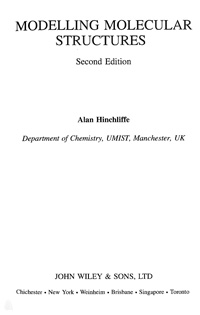Modelling Molecular Structures, изд. 2
| Автор(ы): | Hinchlffe Alan
06.10.2007
|
| Год изд.: | 2000 |
| Издание: | 2 |
| Описание: | Theoretical chemistry is one of the most rapidly advancing and exciting fields in the natural sciences today. This book is designed to show how the results of theoretical chemistry permeate and enlighten the whole of chemistry together with the multifarious applications of chemistry in modern technology. The aim of the authors is to present the latest fundamental material for research chemists, lecturers and students across the breadth of the subject, reaching into the various applications of theoretical techniques and modeling. |
| Оглавление: |
 Обложка книги.
Обложка книги.
Preface to the First Edition [13] Preface to the Second Edition [17]] 0 Prerequisites [1] 0.1 What is a Chapter 0? [3] 0.2 Branches of Mechanics [4] 0.3 Vectors, Vector Fields and Vector Calculus [4] 0.4 Vector Calculus [7] 0.5 Newton's Laws of Motion [11] 0.6 Basic Electrostatics [13] 0.7 The Schrodinger Equation [16] 0.8 Systems of Units [20] 1 Molecular Mechanics [24] 1.1 Vibrational Motion [24] 1.2 Normal Modes of Vibration [28] 1.3 The Quantum-Mechanical Treatment [29] 1.4 The Taylor Expansion [35] 1.5 The Morse Potential [36] 1.6 More Advanced Empirical Potentials [37] 1.7 Molecular Mechanics [38] 1.8 Professional Molecular Mechanics Force Fields [44] 1.9 A Sample MM Calculation: Aspirin [46] 1.10 The Graphical User Interface [48] 1.11 General Features of Potential Energy Surfaces [51] 1.12 Other Properties [56] 1.13 Protein Docking [56] 1.14 Unanswered Questions [57] 2 Dynamics [58] 2.1 Equipartition of Energy [59] 2.2 Ensembles [60] 2.3 The Boltzmann Distribution [60] 2.4 Molecular Dynamics [62] 2.5 Collection of Statistics [64] 2.6 Simulation of Systems [64] 2.7 The Monte Carlo Method [69] 3 The Hydrogen Molecule Ion [72] 3.1 The Born-Oppenheimer Approximation [73] 3.2 The LCAO Model [76] 3.3 Integral Evaluation [77] 3.4 Improving the Atomic Orbital [80] 3.5 More Advanced Calculations [81] 3.6 Visualization [82] 4 The Hydrogen Molecule [85] 4.1 The Non-Interacting Electron Model [87] 4.2 The Valence Bond Model [88] 4.3 Indistinguishability [89] 4.4 Electron Spin [91] 4.5 The Pauli Principle [91] 4.6 The Dihydrogen Molecule [92] 4.7 Configuration Interaction [94] 4.8 The LCAO-Molecular Orbital Model [95] 4.9 Comparison of Simple VB AND LCAO Treatments [97] 4.10 Slater Determinants [97] 5 The Electron Density [99] 5.1 The General LCAO Case [102] 5.2 Population Analysis [103] 5.3 Density Functions [106] 6 The Hartree-Fock Model [109] 6.1 The LCAO Procedure [113] 6.2 The Electronic Energy [117] 6.3 The Koopmans Theorem [117] 6.4 Open-Shell Systems [118] 6.5 Unrestricted Hartree-Fock Theory [120] 6.6 The J and К Operators [121] 7 The Hiickel Model [122] 7.1 Examples [124] 7.2 Bond Lengths and the Huckel model [126] 7.3 Molecular Mechanics of ?-Electron Systems [127] 7.4 Alternant Hydrocarbons [127] 7.5 Treatment of Heteroatoms [128] 7.6 Extended Huckel Theory [129] 7.7 The Nightmare of the Inner Shells [133] 7.8 But What is the Huckel Hamiltonian? [134] 8 Neglect of Differential Overlap Models [135] 8.1 The тг-electron Zero Differential Overlap Models [136] 8.2 The Identity of the Basis Functions [143] 8.3 The 'All Valence Electron' NDO models [144] 9 Basis Sets [154] 9.1 Hydrogenic Orbitals [155] 9.2 Slater's Rules [157] 9.3 Clementi and Raimondi [158] 9.4 Gaussian Orbitals [161] 9.5 The STO/nG Philosophy [164] 9.6 The STO/4-31G Story [167] 9.7 Extended Basis Sets [168] 9.8 Diffuse and Polarization Functions [170] 9.9 Effective Core Potentials [171] 10 Ab Initio Packages [173] 10.1 Level of Theory [174] 10.2 Geometry Input [174] 10.3 An Ab Initio HF-LCAO Calculation [178] 10.4 Visualization [184] 11 Electron Correlation [186] 11.1 Configuration Interaction [189] 11.2 Perturbation Theory [197] 11.3 M011er-Plesset Perturbation Theory [199] 11.4 The Dineon Pair Potential [201] 11.5 Multiconfiguration SCF [203] 11.6 Quadratic Configuration Interaction [206] 11.7 Resource Consumption [208] 12 Slater's Xer Model [209] 12.1 The Exchange Potential [211] 12.2 The Drade Model [211] 12.3 Pauli's Model [212] 12.4 The Thomas-Fermi Model [213] 12.5 The Atomic Xa Model [214] 12.6 Slater's Multiple Scattering Xa Method for Molecules [215] 13 Density Functional Theory [218] 13.1 The Hohenberg-Kohn Theorem [221] 13.2 The Kohn-Sham Equations [224] 13.3 The Local Density Approximation [225] 13.4 Beyond the Local Density Approximation [225] 13.5 The Becke Exchange correction [225] 13.6 The Lee-Yang-Parr Correlation Potential [226] 13.7 Quadrature [226] 13.8 A Typical Implementation [227] 14 Potential Energy Surfaces [230] 14.1 A Diatomic Molecule [231] 14.2 Characterizing points on a Potential Energy Surface [232] 14.3 Locating Stationary Points [234] 14.4 General Comments [238] 14.5 Steepest Descents [238] 14.6 The Fletcher-Reeves Algorithm [238] 14.7 The Hellman-Feynman Theorem [239] 14.8 The Coupled Hartree-Fock (CPHF) Model [240] 14.9 Choice of Variables [241] 14.10 Normal Coordinates [245] 14.11 Searching for Transition States [249] 14.12 Surface-Fitting [249] 15 Dealing with the Solvent [252] 15.1 Langevin Dynamics [252] 15.2 The Solvent Box [253] 15.3 The Onsager Model [254] 15.4 Hybrid Quantum-Mechanical and Molecular Mechanical Methods [260] 16 Primary Properties and their Derivatives [265] 16.1 Electric Multipole Moments [266] 16.2 The Multipole Expansion [269] 16.3 Charge Distribution in an External Field [271] 16.4 Implications of Brillouin's Theorem [271] 16.5 Electric Dipole Moments [272] 16.6 Analytical Gradients [276] 16.7 Electric Quadrupole Moments [276] 16.8 Electric Field Gradients [277] 16.9 The Electrostatic Potential [279] 17 Induced Properties [282] 17.1 Induced Dipoles [282] 17.2 Energy of Charge Distribution in Field [283] J7.3 Multipole Polarizabilities [284] 17.4 Polarizability Derivatives [285] 17.5 A Classical Model of Dipole Polarizability [285] 17.6 Quantum-Mechanical Calculations of Static Polarizabilities [287] 17.7 Derivatives [290] 17.8 Interaction Polarizabilities [292] 17.9 The Hamiltonian [294] 17.10 Magnetizabilities [296] 17.11 Gauge Invariance [296] 17.12 Non-Linear Optical Properties [298] 17.13 Time-Dependent Perturbation Theory [298] 17.14 Time-Dependent Hartree-Fock Theory [300] 18 Miscellany [302] 18.1 The Floating Spherical Gaussian (FSGO) Model [302] 18.2 Hyperfine Interactions [304] 18.3 Atoms in Molecules [316] 18.4 Thermodynamic Quantities [319] References [325] Index [331] |
| Формат: | djvu |
| Размер: | 4677388 байт |
| Язык: | ENG |
| Рейтинг: |
297
|
| Открыть: | Ссылка (RU) |